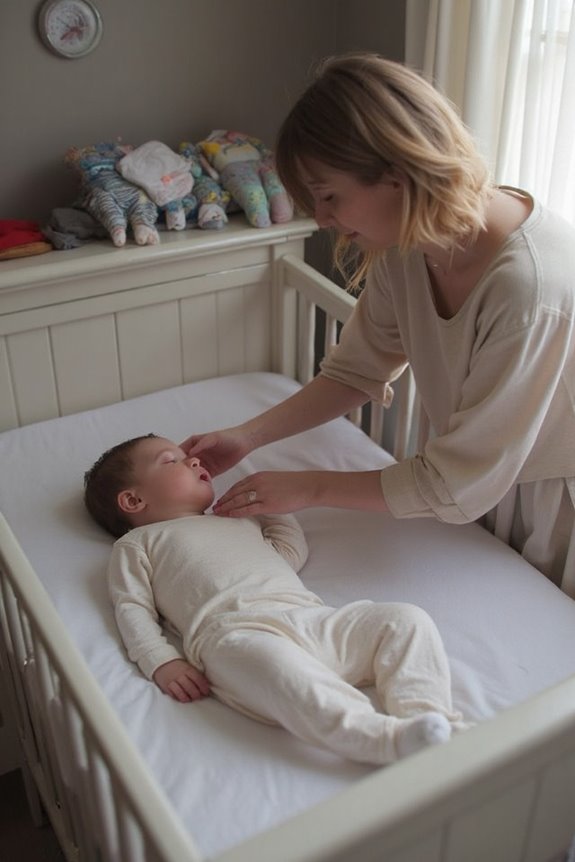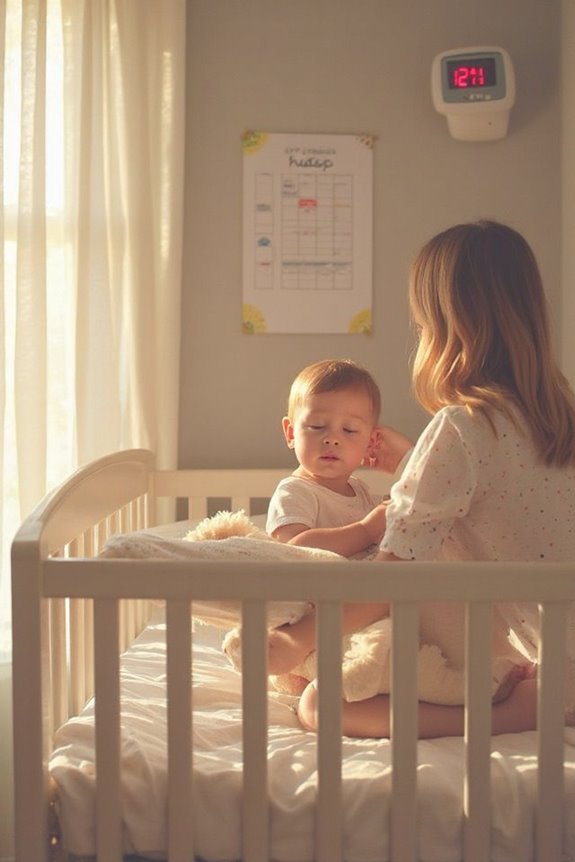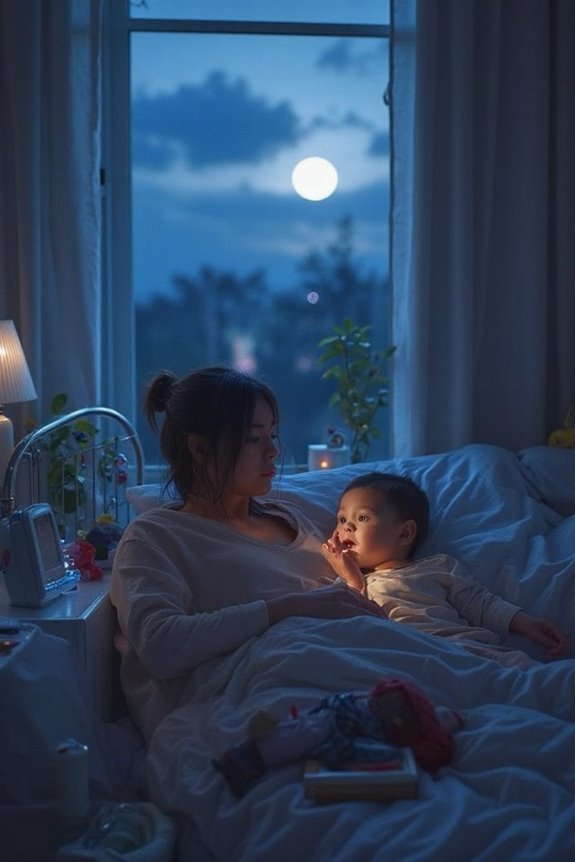I don’t recommend pillows for babies until they’re at least 2 years old, per American Academy of Pediatrics guidelines. Pillows pose serious suffocation risks to infants and young toddlers. Wait until your child has fully shifted to a toddler bed (typically 18-24 months) and shows good head and neck control. When it’s time, choose only thin, firm toddler-specific pillows made of breathable materials. The following sections explore important safety considerations for this critical change.
Key Takeaways
- Babies should not use a pillow until at least 2 years old, as recommended by the American Academy of Pediatrics.
- Pillows pose significant suffocation risks for infants under 12 months and should never be used during this period.
- Developmental readiness for a pillow includes good head/neck control and successful transition to a toddler bed.
- When introducing a pillow (after age 2), choose thin, firm, toddler-specific pillows made from breathable, hypoallergenic materials.
- Consult your pediatrician before introducing a pillow to ensure your child is developmentally ready.
The 2-Year Rule: When Babies Are Ready for Pillows
Three key factors determine when babies can safely use pillows: age, development, and safety guidelines. The American Academy of Pediatrics (AAP) firmly recommends waiting until your child is at least 2 years old before introducing a pillow into their sleep environment.
Developmental Readiness
At age 2, children typically have:
- Better motor control to adjust their position
- Reduced suffocation risk due to improved reflexes
- Ability to move away from potential breathing hazards
When moving to toddler comfort, select appropriate pillow types – thin and firm options minimize risks. A safe sleep environment remains critical throughout early childhood.
Before this milestone, babies need only a firm, flat surface for safe sleep. I recommend consulting your pediatrician about your child’s specific developmental readiness before making this important sleep safety adjustment.
Understanding SIDS Risks Associated With Pillows
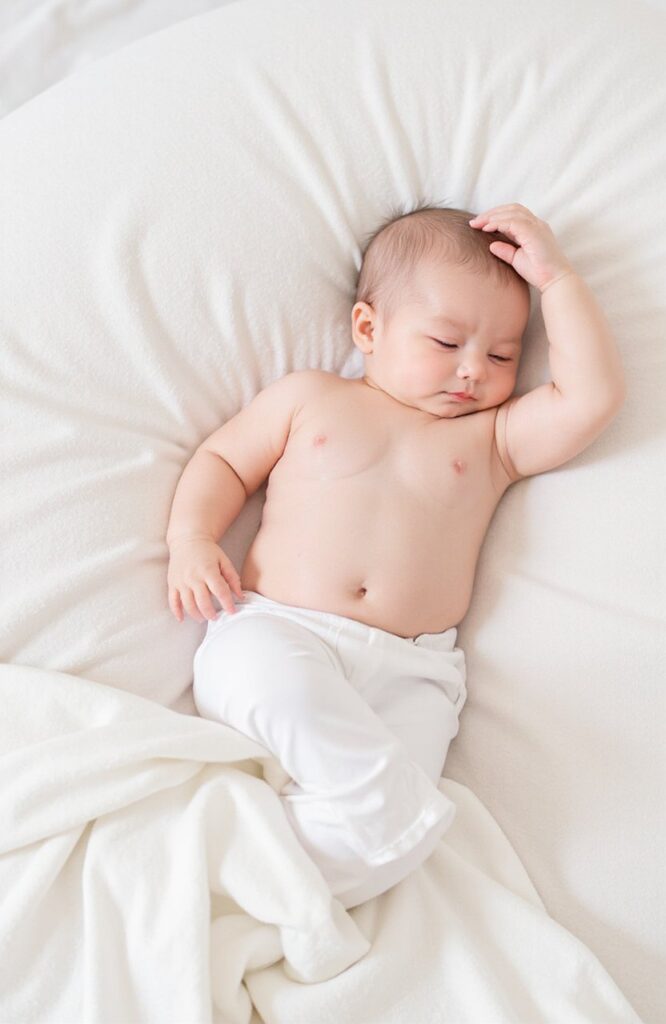
Now that we’ve established when babies can use pillows, let’s examine why these guidelines exist. The connection between pillows and SIDS awareness is essential for every parent to understand.
When an infant’s face presses against a pillow, it can obstruct their airway, increasing suffocation risk. This danger is particularly high for babies under four months old. Research shows:
- Nursing pillows were found in the sleep spaces of infants who died from SUID
- Almost all these deaths occurred during bed-sharing
- Black or African American infants showed higher incidence rates
Pillow safety means ensuring your baby sleeps on a firm, flat surface without any soft objects nearby. New regulations now require warning labels on nursing pillows, highlighting that they should never be used in infant sleep environments.
AAP Guidelines for Safe Infant Sleep Environments
Since the American Academy of Pediatrics (AAP) first published its safe sleep recommendations in 1992, these guidelines have evolved to reflect the latest research on preventing Sudden Infant Death Syndrome (SIDS) and other sleep-related infant deaths.
The current AAP guidelines for infant sleep emphasize several key practices:
- Place babies on their backs for every sleep until they reach 12 months
- Use a firm, flat sleep surface covered with a fitted sheet
- Room-share without bed-sharing for at least 6 months
- Keep the sleep area free from all soft objects and safe bedding including pillows, blankets, and toys
- Avoid inclined surfaces and devices marketed for sleep positioning
I cannot stress enough that following these guidelines consistently across all sleep periods—including naps—is essential for your baby’s safety.
Signs Your Toddler Is Ready for a Pillow
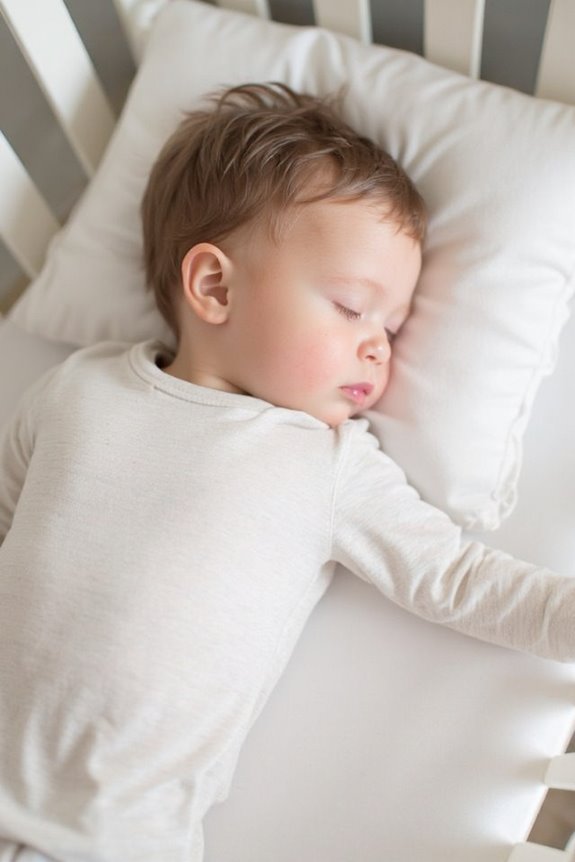
Knowing when your toddler is ready for a pillow requires careful observation of several developmental milestones rather than simply following an age recommendation. While 18-24 months is typically the earliest appropriate age, I recommend conducting a thorough sleep environment assessment first.
Look for these key indicators of toddler pillow readiness:
- Child has good head and neck control
- Successfully moved to a toddler bed
- Uses stuffed animals or blankets as makeshift pillows
- Shows restlessness or discomfort during sleep
- Frequently sleeps on their side
- Directly requests a pillow or imitates others using one
If your toddler displays these signs and is at least 18 months old, they may be ready for a small, firm toddler pillow—but always consult your pediatrician first.
Choosing the Right Pillow for Your Toddler
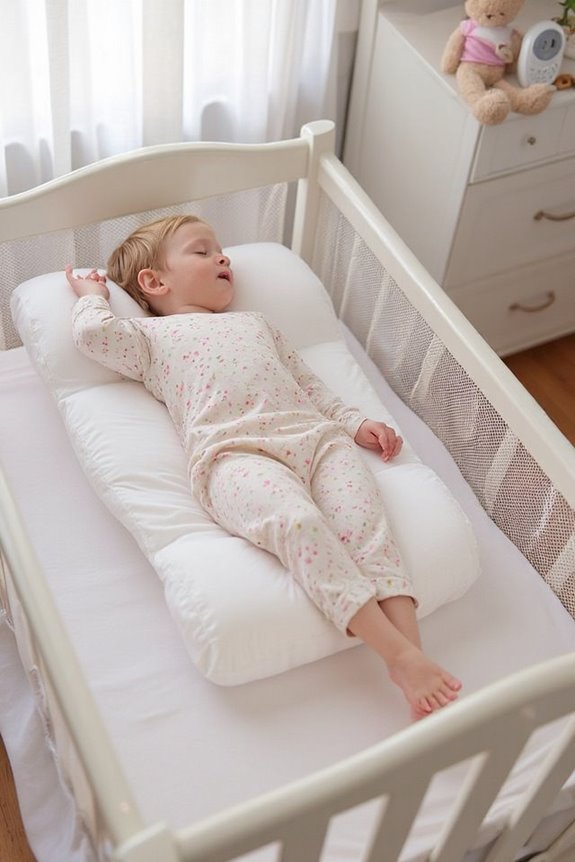
Once you’ve determined your toddler is ready for their first pillow, selecting the right one becomes your next important task. Safety should be your primary concern.
When shopping, focus on these key factors:
- Appropriate pillow size: Look for toddler-specific dimensions (approximately 12×16 inches) that properly fit your child’s proportions
- Support alignment: Choose a medium-firm pillow that maintains proper neck and spine alignment
- Safety features: Select pillows with:
- Breathable, hypoallergenic materials like organic cotton
- Safety certifications (GOTS, OEKO-TEX, CertiPUR-US)
- Machine-washable construction
- Snug-fitting pillowcases
- Safety features: Select pillows with:
Never use adult-sized pillows, which pose suffocation risks. Avoid overly soft pillows that can compromise breathing. Regularly inspect the pillow for wear and replace as needed to maintain safety standards.
Safe Alternatives Before the Age of Two
While babies younger than two years old shouldn’t use pillows, there are plenty of safe alternatives to keep your little one comfortable during sleep. The American Academy of Pediatrics emphasizes that a firm, flat mattress covered with only a fitted sheet provides the safest sleep environment.
Instead of pillows, consider these safe sleep practices:
- Encourage regular tummy time during waking hours to strengthen neck muscles
- Use breathable, firm alternative sleep surfaces that meet safety standards
- Place your baby on their back for every sleep
- Keep the crib free of blankets, stuffed animals, and other soft objects
Remember that proper positioning on a firm mattress actually provides all the support your baby needs. These measures not only promote comfort but greatly reduce SIDS risk during your child’s first two years.
Transitioning From Crib to Toddler Bed With Pillows
The big day arrives when your little one outgrows their crib, usually between 18-24 months of age. This milestone marks when you can safely introduce a small pillow to their sleep environment.
For a safe toddler bed setup, I recommend:
- Using a small (12×16 inches), medium-firm pillow made of breathable materials
- Ensuring pillowcases fit snugly without excess fabric
- Keeping the bed free of stuffed animals, toys, and extra blankets
Follow these pillow safety guidelines:
- Choose hypoallergenic, machine-washable options
- Check that the pillow supports your child’s head and neck in a neutral position
- Regularly inspect for wear or damage
Maintain a consistent bedtime routine as your child adjusts to these changes, and continue monitoring their comfort and safety.
Common Myths About Babies and Pillows Debunked
Despite what many well-meaning parents and grandparents believe, numerous myths about babies and pillows continue to circulate that could put infants at risk.
Myth 1: Soft pillows are safe for babies. The truth is all pillows pose significant suffocation risks to infants under 12 months.
Myth 2: Pillows prevent SIDS. No evidence supports this claim. In fact, pillows increase SIDS risk by potentially trapping carbon dioxide.
Myth 3: Pillows improve infant sleep quality. Babies sleep perfectly well without pillows, which is actually safer.
Myth 4: Babies need pillows for support. Infants’ heads and necks don’t require pillow support during sleep.
Myth 5: Any pillow is suitable. Even when age-appropriate, only firm, thin pillows designed specifically for toddlers should be considered for pillow safety in infant sleep environments.
How Pillows Affect Breathing and Temperature Regulation
Understanding why pillows pose dangers to infants goes beyond just the risk of suffocation. When a baby’s face comes in contact with a pillow, it can disrupt normal breathing patterns in several ways:
- Airflow Obstruction: Pillows can block air passages and increase resistance to normal breathing
- CO2 Rebreathing: Babies may rebreathe exhaled carbon dioxide when their face is against pillow material
- Positional Asphyxia: Certain pillow-induced positions can restrict chest movement
Temperature control is another critical concern. Pillows can:
- Retain heat near a baby’s head and face
- Accumulate moisture, increasing infection risks
- Create an environment that contributes to overheating
These factors explain why medical experts recommend a firm, flat sleep surface with no pillows until at least 12 months of age.
Expert Recommendations for Safe Sleep Practices
Leading health organizations across the world have established clear guidelines for infant sleep safety that I’ll share with you now.
The American Academy of Pediatrics (AAP) strongly advises against pillow use for infants under 12 months due to suffocation risks. They emphasize:
- Maintain proper sleep posture by always placing babies on their backs
- Use only a firm, flat mattress with a fitted sheet
- Keep cribs free of pillows, blankets, and soft toys
- Share your room (not your bed) with your baby for at least 6 months
For ideal pillow safety, wait until your child moves to a toddler bed (typically 18-24 months). Even then, use only thin, firm pillows designed specifically for toddlers. Remember that consistent safe sleep practices across all caregivers is vital.
Frequently Asked Questions
Can Special Orthopedic Pillows Help Babies With Reflux Problems?
My neighbor’s baby struggled terribly with reflux. Special orthopedic pillows can aid in reflux management and improve baby comfort, but always consult your pediatrician first as they pose suffocation risks for infants.
Should Pillow Introduction Differ for Premature Babies?
I’d follow the same two-year rule for premature babies. They need even greater caution with pillow safety due to potential underdeveloped systems. Always prioritize safe premature sleep environments without soft items or pillows.
Do International Safety Standards for Toddler Pillows Vary Significantly?
Walking on eggshells, I’d say yes, international pillow safety standards for toddlers do vary considerably. Some countries specify exact dimensions while others focus more on material requirements for toddler comfort and breathability.
How Do Cultural Practices Affect Pillow Use Across Different Countries?
In my research, I’ve found that cultural norms dramatically influence pillow use worldwide. Sleep practices vary by region, with parenting styles adapting to local traditions—some cultures delay pillows while others create alternative comfort solutions.
Can Transitional Objects Like Loveys Substitute for Pillows?
No, I don’t recommend using loveys as pillow alternatives for babies under 12 months. While lovey benefits include comfort and security, they still pose suffocation risks in sleep spaces until after the first birthday.


